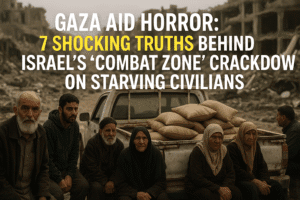Gaza Aid Horror: 7 Shocking Truths Behind Israel’s “Combat Zone” Crackdown on Starving Civilians
Israel’s military has declared roads to Gaza aid hubs “combat zones,” explicitly banning Palestinian travel after troops killed at least 27 civilians waiting for food – the third such deadly incident targeting aid seekers in three days. The IDF justifies shootings by claiming “suspects” advanced threateningly, a stance starkly contradicted by witness accounts of people being shot while simply trying to survive. UN Human Rights Chief Volker Türk unequivocally condemned these attacks on starving civilians seeking aid as potential war crimes.
Trapped by Israel’s blockade, which has pushed half a million Gazans toward starvation despite denials of widespread aid diversion by Hamas, desperate residents face an impossible choice: risk death by gunfire on the roads or slowly starve at home. Compounding the crisis, the US-backed Gaza Humanitarian Foundation (GHF), controversially overseeing aid distribution, closed sites after the killings citing vague “improvements,” while its new leader, Trump-aligned evangelical Johnnie Moore, dismisses reports of Palestinian casualties as “lies spread by terrorists.”
This lethal designation of aid routes effectively normalizes killing the starving, transforming humanitarian access into a death sentence.

Gaza Aid Horror: 7 Shocking Truths Behind Israel’s “Combat Zone” Crackdown on Starving Civilians
The roads leading to food in Gaza now carry an official Israeli death sentence. In a chilling directive, the Israeli military has declared routes to key humanitarian aid distribution hubs “combat zones,” explicitly prohibiting Palestinian travel. This declaration comes not as a preventative measure, but in the grim aftermath of at least 27 Palestinians killed by Israeli fire while waiting for aid on Tuesday – the third such lethal incident targeting aid seekers in just three days.
The “Combat Zone” Justification: The Israel Defense Forces (IDF) stated troops fired “evasive shots” and then “additional shots” near a Gaza Humanitarian Foundation (GHF) distribution point after “suspects” moved towards them “in a way that posed a threat.” This explanation, offered only after international outcry over previous similar killings, rings hollow to witnesses and families of the victims. Fadi Abu Mohammad recounts the death of his 22-year-old relative, Mohammad Abu Shamala: “He was struck by a bullet in the back and died instantly… He was supposed to get married next month.” The shooting reportedly began nearly a kilometer away from the actual aid hub.
A Cycle of Violence and Desperation: This latest massacre occurred at the same location where over 30 Palestinians were killed by Israeli fire just days earlier while heading to receive food. The UN Human Rights Chief, Volker Türk, minced no words: “Deadly attacks on distraught civilians trying to access the paltry amounts of food aid in Gaza… constitute a grave breach of international law and a war crime.” The Israeli blockade, imposed under claims of Hamas diverting aid (vehemently denied by Hamas and aid officials citing no evidence), has pushed half a million Gazans to the brink of starvation.
As Fadi Abu Mohammad starkly put it, returning to the distribution point is “a huge risk and a potential death sentence, but everyone who went had no other choice. If they aren’t killed by bullets or shelling, they will die of hunger.”
The Controversial GHF Factor: Adding layers of complexity is the role of the US-backed Gaza Humanitarian Foundation (GHF), which controversially took over food distribution despite UN and humanitarian agency objections. Critics argued the system was inadequate for Gaza’s 2.3 million people and effectively allowed Israel to weaponize food access. The GHF expressed being “saddened” by Tuesday’s deaths, blaming civilians for moving “beyond the designated safe corridor.” Its immediate response? Closing distribution points Wednesday for vague “update, organisation and efficiency improvement work.”
Simultaneously, the GHF faces a leadership crisis. Its former head, Jake Wood, resigned citing an inability to guarantee independence from Israeli interests. He was replaced by Johnnie Moore, a prominent US evangelical leader and Trump advisor, known for aggressively defending the GHF and dismissing reports of Palestinian casualties as “lies spread by terrorists.”
The Human Cost of a “Combat Zone”: The IDF’s designation of aid routes as “combat zones” is not a protective measure; it is a retroactive justification that normalizes the killing of civilians engaged in the most fundamental act of survival: seeking food. It transforms the very pathways to sustenance into sanctioned killing fields. The warning against travel is not a safeguard; it is an admission of lethal intent.
The Unbearable Calculus: Gaza’s civilians are trapped in an impossible calculus: risk death by Israeli fire on the roads designated for aid, or face the slow, agonizing death of starvation at home. The international condemnation of these attacks as potential war crimes underscores the gravity of the situation. When seeking bread becomes synonymous with a death sentence, the very concept of humanitarian aid collapses under the weight of military strategy and political failure. The roads to Gaza’s aid hubs now symbolize not hope, but the terrifying normalization of killing the starving.
You must be logged in to post a comment.